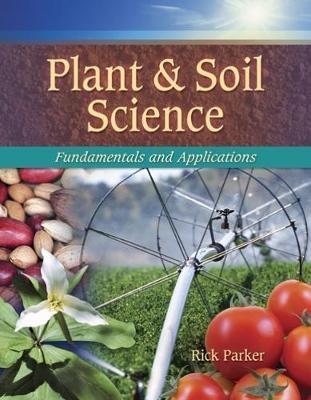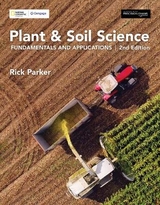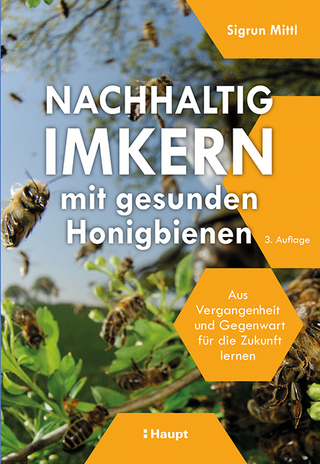
Plant & Soil Science
Delmar Cengage Learning (Verlag)
978-1-4283-3480-9 (ISBN)
- Titel erscheint in neuer Auflage
- Artikel merken
Plant & Soil Science: Fundamentals and Applications leads the learner through four major sections, Introduction to Plants, Fundamentals of Soil Science, Fundamentals of Plant Growth and Propagation, and Crops – Applied Plant and Soil Science. Organized into twenty-eight chapters, each chapter features learning objectives, key terms (defined in the glossary), tables, charts, illustrations and color photographs to aid the learning and teaching process. Learning objectives at the beginning of each chapter indicate to the student and the teacher the important concepts. The review questions at the end of each chapter are tied to the learning objectives to help assess the students grasp of key concepts contained within each chapter. Similarly, additional resources are listed at the end of each chapter, and a "Knowledge Applied" section contains student activities designed to get the students "doing" so that they begin "understanding" plant and soil science. In the final chapter, students who enjoy learning about and working with plants and soils can learn more about employing the necessary skills and education for a career paths in plant and soil science.
Dr. R.O. Parker is currently director and journal editor for North American Colleges and Teachers of Agriculture (NACTA) and president of the National Agricultural Institute. He is a past director of AgrowKnowledge, the National Center for Agriscience and Technology Education, a project funded by the National Science Foundation. As a former division director at the College of Southern Idaho (CSI), Dr. Parker worked in agriculture, information technology, drafting, and electronics, and taught computer, agriculture, and writing classes. In 1992, he received an honorary state Future Farmers of America (FFA) degree from Idaho, and in 2005, he received an honorary American FFA degree at the 78th National FFA Convention. From 2005 to 2008 he served as a board member of The National Council for Agricultural Education (The Council), and he is the 2008 recipient of the NACTA Distinguished Educator Award and the 2010 recipient of the NACTA Murray Brown Leadership Award. Dr. Parker has authored several Cengage textbooks, including PLANT & SOIL SCIENCE, AQUACULTURE SCIENCE, INTRODUCTION TO PLANT SCIENCE, and INTRODUCTION TO FOOD SCIENCE & FOOD SYSTEMS, among other contributions). He earned his undergraduate degree from Brigham Young University and a Ph.D. in reproductive physiology from Iowa State University, and he completed post-doctoral work at the University of Alberta, Edmonton, and the University of Wyoming, Laramie.
PART 1: INTRODUCTION TO PLANTS.
1: The Plant Kingdom.
Objectives. Key Terms. Introduction. Evolution of Plants. Geographical Distribution. Roles of Plants. Taxonomy. Research. Summary. Review. Knowledge Applied. Resources.
2: Origins of Cultivated Plants.
Objectives. Key Terms. Origin and Development of Cultivated Plants. New Crops and New Uses. Protection of Germplasm. Summary. Review. Knowledge Applied. Resources.
3: Structure of Cultivated Plants.
Objectives. Key Terms. Plan of the Entire Plant. Seeds. Using Plant Structure. Summary. Review. Knowledge Applied. Resources.
4: Anatomy of Plants.
Objectives. Key Terms. The Cell and Its Structure. Tissues. Anatomy of Primary Organs. Primary and Secondary Growth. Summary. Review. Knowledge Applied. Resources.
PART 2: FUNDAMENTALS OF SOIL SCIENCE.
5: Soil Materials and Formation.
Objectives. Key Terms. Introduction to Soils. Rocks and Minerals. Five Factors. Soil Profile. Summary. Review. Knowledge Applied. Resources.
6: Soil Characteristics, Classifications and Use.
Objectives. Key Terms. Soil Definitions. Physical Properties. Chemical Properties. Organic Matter. Soil Classification. Summary. Review. Knowledge Applied. Resources.
7: Soil Fertility and Management.
Objectives. Key Terms. Essential Nutrients and their Roles in Plants. Fertilizers. Secondary and Micronutrients. Nutrient Availability and Plant Uptake. Nutrient Interactions. Soil pH. Soil Testing. Foliar Symptoms. Choosing the Fertilizer Source. Fertilizer Placement. Other Fertilizer Sources. Animal Manures. Compost. Soil Management. Summary. Review. Knowledge Applied. Resources.
8: Soil-less Plant Production.
Objectives. Key Terms. Container Growing. Hydroponics. Aquaponics. Summary. Review. Knowledge Applied. Resources.
9: Irrigation.
Objectives. Key Terms. Characteristics of Water. Role of Water In Plants. Precipitation. Water Loss in Plants. Water for Plants. Movement of Water. Water in the Soil. Irrigation. Summary. Review. Knowledge Applied. Resources.
10: Soil and Organic Farming.
Objectives. Key Terms. Organic Farming. Crop Nutrition. Choice of Crops. Crop Rotations. Weed Control. Pest and Disease Control. Genetic Diversity. Use of Water. Animals and Organic Growing. Sustainable Agriculture. Summary.
PART 3: FUNDAMENTALS OF PLANT GROWTH AND PROPAGATION.
11: Temperature.
Objectives. Key Terms. Biological Temperature Range. Climatic Classification. Growing Degree Days. Vernalization. Temperature Stress. Summary. Review. Knowledge Applied. Resources.
12: Light.
Objectives. Key Terms. Nature of Light. Sunlight. Photoperiodism. Artificial Illumination. Summary. Review. Knowledge Applied. Resources.
13: Photosynthesis.
Objectives. Key Terms. Nature of Light. Structure of the Plant Photosystem. Changing Light Energy into Chemical Energy. Factors Affecting Photosynthesis. The Carbon Cycle. Storage of the Products of Photosynthesis. Summary. Review. Knowledge Applied. Resources.
14: Respiration.
Objectives. Key Terms. Sugar into Energy. Necessity of Respiration. How Plant Respiration Affects Agriculture. Fermentation. Summary. Review. Knowledge Applied. Resources.
15: Basics of Plant Growth.
Objectives. Key Terms. Regions of Growth. Concepts and Components of Growth. Cells. Basic Genetics. Measuring and Modeling Plant Growth. Summary. Review. Knowledge Applied. Resources.
16: Vegetative Growth.
Objectives. Key Terms. Growth. Seed Germination. Roots. Shoot Growth. Factors Affecting Plant Growth and Development. Phase Changes. Summary. Review. Knowledge Applied. Resources.
17: Plant Propagation.
Objectives. Key Terms. Sexual Reproduction. Asexual Reproduction. Micropropagation. Plant Improvement. Summary. Review. Knowledge Applied. Resources.
18: Plant Pests.
Objectives. Key Terms. Weeds. Plant Growth Regulators. Diseases. Disease Development. Other Pests. Integrated Pest Management (IPM). Summary. Review. Knowledge Applied. Resources.
19: Genetic Engineering and Biotechnology.
Objectives. Key Terms.Biotechnology Defined.
| Erscheint lt. Verlag | 1.2.2009 |
|---|---|
| Verlagsort | Clifton Park |
| Sprache | englisch |
| Maße | 221 x 36 mm |
| Gewicht | 1935 g |
| Themenwelt | Weitere Fachgebiete ► Land- / Forstwirtschaft / Fischerei |
| ISBN-10 | 1-4283-3480-7 / 1428334807 |
| ISBN-13 | 978-1-4283-3480-9 / 9781428334809 |
| Zustand | Neuware |
| Haben Sie eine Frage zum Produkt? |
aus dem Bereich



